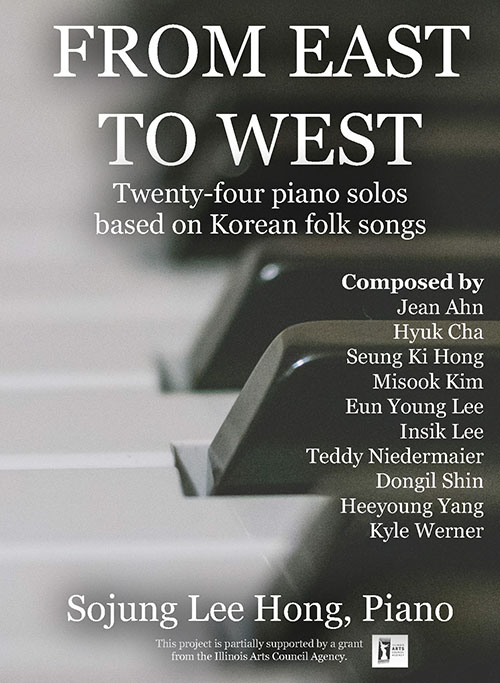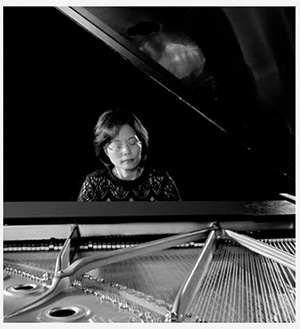1. Arirang Fantasia (2005) by Hyuk Cha
Arirang Fantasia is based on two Korean folk songs: Jindo Arirang and Gyeonggi Arirang. Arirang is agreed to be the most well-known folk song of Korea, and each province of Korea has passed on various versions of Arirang. This piano solo juxtaposes the distinct characters of the two Arirang themes by using different rhythms, harmonies, and articulations. The spontaneous musical ideas cast in the introduction return at the coda. Both the improvisatory spirit in the outer sections and the exciting contrast between the two folk tunes in the main section create structural beauty and balance, satisfying the concept of fantasia.
2. The Beggar’s Song (2006) by Dongil Shin
The melody of The Beggar’s Song is taken from a Korean folk song, Jang Taryeong (Street Market Song). Traditionally, this song had been sung by beggars called Pumbaa, singing and dancing wanderers who entertained spectators at street markets. In this miniature piano solo, the rhythm of the folk song in bold harmonies conveys the liveliness of an open-air market.
3. Longing for the Sun (2006) by Dongil Shin
The tune used in Longing for the Sun is a Korean traditional nursery rhyme that was believed to be sung when children were waiting for the sun. The quiet mood at the beginning of the piece describes the calmness before the sun comes out. The music gets faster and more vivid in the second part to describe children playing happily under the sun after it finally arrives.
4. Song of Roasted Chestnut (2007) by Dongil Shin
Gunbam Taryeong (Song of Roasted Chestnut) is a folk song from the Gyeonggi Province. This song is characterized by merry yet sarcastic lyrics with a delightful refrain which cheers tasty roasted chestnuts in fast 12/8 meter. The piece consists of three sections
which depict multiple stanzas of the song. The lively mood develops through sections until it reaches a climax with running 16th-note and octave passages at the end.
5. Ongheya (2007) by Jean Ahn
Ongheya is one of the most famous farming songs in Korea. An antiphonal song, it features a‘call and response’ between the leader and the farmers. This work enhances the antiphonal character of the song by using the high contrast of each side. Throughout the piece, the communal spirit of the farmers is emphasized.
6. Tae-Pyung-Ga (2010) by Eun Young Lee
The lyrics of Tae-Pyung-Ga expresses the effort to overcome mundane anguish by singing joyful tunes. This work was completed at MacDowell Colony in May 2010.
7. Yin-Yang: The Infinity (2010) by Misook Kim
The compositional plot of Yin-Yang (Infinity) reflects the harmony and balance of the Korean flag and comes from simple melodies of the Jeju folk songs. It is strictly written in 5-note scale, Kye-Myun-Jo, with extended use of pedal to express the movement of the universe.
8. Kwe-Ji-Na Ching-Ching Na-Ne (2010) by Misook Kim
Kwe-Ji-Na Ching-Ching Na-Ne is originally a farmers’ song and represents an important musical genre which has been developed mainly by peasants in the agricultural society of Korea. It became a folk song of the Gyeongsang Province. Kwe-Ji-Na Ching-Ching is an onomatopoeia of a small brass gong used in traditional Korean folk music. The piece starts with a slow tempo, but then the two main themes keep repeating as a call and response between two contrasting dynamics and registers of piano.
9. Changbu Taryeong (2010) by Misook Kim
Changbu Taryeong is a simple, bright, and cheerful folk song from the Gyeonggi Province. The real treat in this movement is found in the unique harmonies and changing meters that are accompanied with lyrical melody. The last chord is meant to be humorous as it interjects
an otherwise virtuosic passage, and completely stops the momentum of energy.
10. Mong (2012) by Heeyoung Yang
Mong is based on a Korean traditional song named Monggumpo Taryeong. The folk tune is made of a simple pentatonic melody. The title Mong means ‘dream’ and it describes the earnest desire of a woman who longs to meet her beloved, as is implied in the lyrics of the song. The sequence of perfect fifths is used in the beginning and at the end to emphasize the innocent, pure, and sincere love with its high degree of consonance.
11. Rang, Rang (2013) by Eun Young Lee
Rang, Rang for solo piano is based on a Korean folksong, Arirang. In contrast to the broken-hearted mood of the original Arirang, this version is filled with delight. It consists of not only the common classical style but also ragtime that interrupts and interacts with the
original melody.
12. Milyang Arirang (2014) by Teddy Niedermaier
Milyang Arirang stems from Milyang (or Miryang), a city located in the Korea’s southeastern region. The serious, driving melody adheres to the A minor pentatonic scale. The meter follows semachi, a rhythmic pattern in moderate tempo with three beats (expressed here as 9/8 time), with the final two beats exchanging long-short and short-long rhythms. In measure 24, the Arirang melody temporarily disappears, and the semachi pattern comes to the fore. Like many other Korean folk songs, Milyang Arirang casts a complex web of
emotions including loss, beauty, nostalgia, pain, and devotion.
13. Bluebird, Bluebird (2014) by Teddy Niedermaier
Sung as a lullaby, the original Korean melody, “Birds, Birds, Bluebirds” contains only three pitches: D, G, and A. Filled with large leaps and perfect intervals, the melody creates an empty and mysterious feeling. This arrangement preserves the leaps and intervals of the original melody, but immediately introduces new pitches that suggest a dark mixture of the G major and G Phrygian scales.
14. Song of the Roasted Chestnuts (2014) by Teddy Niedermaier
“Gunbam Taryeong” (Gunbam means roasted chestnut) follows a quick and vivacious rhythmic pattern called jajinmori jangdan; the fastest rhythmic structure found in Gyeonggi folk music. The lyrics bask in the delights of nature: relishing the sea, a refreshing breeze, the coming of spring, and the taste of freshly roasted chestnuts. In western notation, this translates into an
Allegro in duple compound meter, replete with syncopation, ties, and grace notes that enliven
the rhythmic profile. Cross-hand arpeggios, persistent eighth notes, and leaps generate energy and momentum.
15. Distant Fields (2015) by Kyle Werner
Distant Fields references two traditional Korean melodies: Parang-Sae (Blue bird) and Chung-Sung-Gok (also spelled Cheongsong-gok). Parang-Sae, a lullaby, appears in its entirety in the left hand at the beginning of the piece. This melody becomes the repeating base line of a passacaglia, over which quotations from Chung-Sung-Gok emerge in the right hand, like distant bird calls. The music gradually moves from a gentle, soothing atmosphere to a mysterious
dream-like state during which the two melodies disappear for a time, returning later in a majestically transformed character. The lullaby and memory become a dream, which then becomes a reality.
16. Arirang Variations for Piano Solo (2015) by Seung Ki Hong
Arirang Variations for Piano Solo uses Gyeonggi Arirang as a main theme of the variations. Throughout the variations, such musical elements as tempo, harmony, and rhythm keep changing in the styles of waltz, polonaise, and tango. In particular, the final variation, written as a tango in a minor key, mysteriously evokes emotions described in the lyrics of Arirang:
17. Curious Cuckoo (2016) by Heeyoung Yang
Among many kinds of birds mentioned in the folk song, Sae Taryeong (Blue Bird) which serves as the basis of this piece, the cuckoo is the only bird whose birdcall is directly used in the
melody. The distinctive call of the cuckoo is used, and the descending chromatic line supports the original tune.
18. Popping Chestnuts (2016) by Heeyoung Yang
Popping Chestnuts is based on the folk song Gunbam Taryeong (Song of Roasted Chestnuts). In this short piece, the process of roasting chestnuts is described using the original tune and
staccato with a light touch of popping sounds.
19. Fantasie from ‘Hanobaeknyeon’ (2016) by Insik Lee
Hanobaeknyon (translated as ‘five hundred years’) is a popular folk song from the Gangwon Province and sung in a very slow rhythm. The title comes from the refrain “of course, of course, let’s live together for five hundred years.”
20. A Meandering Path: Toccatina (2017) by Heeyoung Yang
Ari-Gogae (which means ‘a meandering on high hills’), one of many different arguments on the origin of the term Arirang, has inspired me to start composing this piece. A journey for a long trip along a meandering on high hills, as described in the lyrics, is depicted in this toccatina.
21. Blue Wave: on a Theme of Arirang (2018) by Heeyoung Yang
One of the proposed theories regarding the origins of the popular Korean folk song Arirang lies in a combination of two words: ari (blue) and irang (wave). This short piece paints various images of water waves using the tune of Arirang as its main motif.
22. Balloon Flower Waltz in Wonderland (2019) by Heeyoung Yang
This short piece is based on the Korean traditional song, Doraji Taryeong (Balloon Flower Song). How would it sound if Doraji Taryeong is sung by Alice in Wonderland?
23. Maidens’ Circle Dance (2020) by Misook Kim
Ganggangsullae is an ancient Korean dance. It incorporates singing and dancing, exclusively performed by women. Maidens’ Circle Dance describes the image of young and old women holding each other’s hands and dancing in a circle under the moonlight. Two different registers of piano symbolize that the lead singer sings a line and everyone else sings the refrain, ganggangsullae.
24. The Phantom of Arirang (2020) by Misook Kim
The Phantom of Arirang is derived from the folk song, Arirang and the hymn, Amazing Grace, both of which are based on a pentatonic scale. The main ideas from Arirang and Amazing Grace were utilized throughout the work. The piece has a clear three-part structure. After initially expressing the energy and excitement, the second part conveys serious musical monologue and intensifies a rich tonal quality by the sustaining pedal along with the soothing repetitive chords. This effect gradually develops into the final section, Quasi una fantasia, along with magnificent chords in octaves.
These compositions may be purchased on the website of the Sejong Cultural Society. www.sejongculturalsociety.org




